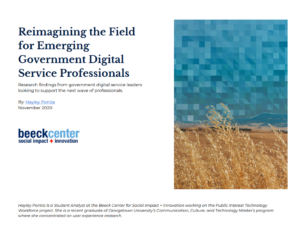Encouraging the Next Generation of Digital Service Professionals to Work in Government
This is the first in a three-part series on the American government digital service workforce.
Read parts two and three: Why Governments Should Prioritize UX for Everyone and Skills Needed for Government Digital Service Professionals
November 11, 2020 – By Hayley Pontia
It should be startling that less than 5% of federal government employees are between the ages of 22-29. Not only are young professionals willing to adapt and learn potentially more readily than those fixed in a system, but they may also be more capable of helping governments overcome technological problems by proactively using data and technology to better carry out their missions in this digital age.
Ironically, some of the most knowledgeable people in the areas of technology and digital services are those Generation Z and Millennials who grew up with technology and are newer to entering the workforce — those same 22-29-year-olds barely represented in state, local, or federal government. They are the “digital natives” who can quickly adapt and learn new technological skills. They already possess the foundation that many in government may actively be working toward or relying on others to support. Because this talent pool is eager to jump into public service roles, technology and innovation leaders should focus more efforts on the recruitment and career development of this cohort of emerging professionals. Digital natives are a valuable asset to any organization and need career pathways towards government digital service.

In March 2020, a group of student Mozilla Builders launched Impactful, an online platform for technologists to develop their careers in social good by connecting them with socially-impactful opportunities and with other impact-driven technologists. Recently, in the wake of the COVID-19 pandemic, community platforms such as Remote Students serve as a place where students and recent grads can share opportunities, events, resources, and help each other achieve their career dreams within the tech field.
Those of us coming out of current university programs are learning cutting-edge skills in human-centered design, focusing on how to put people at the center of systems and processes. These skills mean newer, digital native workers are more oriented towards public service, but there are still not as many opportunities available as there are in the private sector. Existing government teams that work in these modern ways, such as the U.S. Digital Service, 18F, Veterans Experience Office, New Jersey Office of Innovation, and San Jose Civic Innovation team are still in early days themselves and most have not yet been able to fully fill in this early part of the career pipeline.
This isn’t to say that those already in the field aren’t trying to create more opportunities for emerging professionals. It is important to recognize the many barriers that existed for the inception of digital service teams as they exist now. But as those teams mature, agency leaders must focus more effort on the career development of this junior part of the pipeline.
Technologists, data scientists, and designers are changing the way government approaches carrying out its mission, and those individuals are also acknowledging the importance of creating entry points to civic tech-related jobs for recent graduates. But government leaders need to provide incentives and pathways obtainable for those seeking digital service in the public sector.
This requires supporting the current ecosystem of professionals in order to allow them space to mentor those entering the field. Coding it Forward launched in 2017 to establish summer fellowships for current students in the federal government and those students are matched with mentors working in the public interest technology field. It’s a great model, but is limited in scope and duration. Roles in places like USDS, 18F, and the Presidential Innovation Fellowship allow mid- and senior-level professionals to focus on following created pathways through these organizations. But what is missing from the equation are pathways for people looking to gain experience in the more interdisciplinary field of public sector technology as junior- or entry-level professionals. Using the framework from research conducted by fellow students last summer, and through the work of the Upskilling the Government Technology Workforce project I’ve been leading at the Beeck Center, we are supporting public sector and public interest teams to prepare to bring in a younger generation digital service skills to actively challenge systems that require modern solutions.
The Beeck Center is tapping into the network of digital service professionals through user research in order to better understand what makes current digital service individuals successful and what they are looking for in those new to the field.
This year, I have been working to enable change for new talent by researching, listening, and creating useful resources for those relatively new to the field of government digital service delivery. As I head out into the workforce myself, I hope to challenge these existing systems that make it difficult for someone eager to use technology for good.
Hayley Pontia is a student analyst at the Beeck Center. She earned a Master of Arts in Communication, Culture and Technology in May 2020 with a focus on user experience research and is currently looking for a pathway into public service. Connect with her at https://www.linkedin.com/in/hayleypontia/. Other examples of her portfolio can be found at https://www.hayleypontia.com.